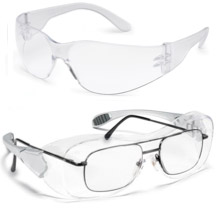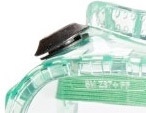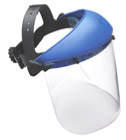Head Protection
Protective helmets are required when working in areas where there is a potential head injury from falling objects or low hanging obstacles. Hard hats are tested for impact and penetration resistance from blows to the top of the head, flammability resistance, and water absorption. ANSI Z89.1 is the standard describing the performance criteria required for different types of hard hats.
OSHA regulations regarding PPE for Head protection are found at 29 CFR 1910.135.
Eye and Face Protection
Eye and face protection, such as safety glasses or face shields, may be required in areas that have the following hazards:
- Accidental splashes of chemicals, bodily fluids, or other hazardous liquids
- Unexpected flying objects or particles (chips, shards) from a nearby machine or hand tool
- Non-ionizing radiation
- UV lights
A risk assessment should be conducted before appropriate eye and face protection is chosen.
Eye and face protection must meet the ANSI Standard Z87.1. Approved safety glasses or goggles will have the ANSI standard number (Z87 or Z87+) imprinted on all parts of the protective wear. Eye and face protection that is UV rated will also be imprinted with a "U" and a number ranging from 2 to 6, with lenses marked "U6" providing the highest level of UV protection.
Safety glasses and goggles come in many different styles and should fit well around the eye area. If there are large gaps around the eyes or slippage occurs, try another style. Prescription glasses are NOT equivalent to safety glasses, unless they are ANSI-rated, and they can make it difficult to find safety glasses that fit comfortably. Safety staff has several samples of safety glasses from vendors for personnel to try on before purchasing. Contact Safety staff if you would like us to bring samples to you.
OSHA regulations relating to Eye and Face protections are found at 29 CFR 1910.133.
 Safety Glasses
Safety Glasses
The use of safety glasses is a good option for protection when hazardous materials are used or there is any risk of injury to the eye. Safety glasses are sufficient for minimal splash hazard and are good for protection against large projectiles.
Safety Goggles
Safety goggles should be worn if there is a moderate risk of splash from a hazardous material. They may also need to be worn when working with high risk chemicals or processes. If the goggles have a cloth or foam seal, these may not provide enough protection from chemical splashes. If possible, purchase googles that are resistant to fogging. Remember, not all goggles protect in the same way.

- Direct vented goggles: allows a direct flow of air from the atmosphere in the lab into the goggles. These are only useful when protectiles are the main concern, as they do not protect against splashes or vapor. May be useful in wood and machine shops.
- Indirect vented goggles: covered vents allow the passage of air between the goggles, but not liquids. These goggles provide protection against splashes, in addition to any projectiles. Before use, make sure that the vent covers are not turned inside-out. Vents positioned this way offer no protection against splashes.
- Non-vented goggles: no venting of any kind. These protect against dust, mist, liquid, and vapor hazards. When the hazards is a gas, these provide adequate protection, though they are not equivalent to gas-proof goggles. Due to the lack of venting, fog may gather quicker in these goggles than the other options.
Face Shield
 Examples of when a face shield should be worn include the following:
Examples of when a face shield should be worn include the following:
- There is a high risk of a splash of hazardous material (e.g. chemical, blood, etc),
- Removing hot liquids from an autoclave,
- Dispensing liquid nitrogen,
- Working with high risk chemicals or processes (e.g. highly reactive chemicals, concentrated corrosives, etc.), and
- Vacuum or pressurized glassware systems.
Disposable face shields are more lightweight, comfortable, and convenient than reusable ones; but may not be appropriate for all applications.
When using a face shield, safety glasses or goggles should be worn underneath.
 Tinted Glasses/Goggles/Face Shield/etc.
Tinted Glasses/Goggles/Face Shield/etc.
Tinted or shaded lenses may be necessary for protection from radiant energy (e.g. lasers and welding). ANSI Z87 approved eye and face protection that is UV-rated will also be imprinted with a "U" and a number ranging from 2 to 6, with lenses marked "U6" providing the highest level of UV protection. Depending on the type of radiant energy, the wavelength of the laser, etc. the kind and color of safety protection will vary. When choosing the correct eye protection, be sure to determine what optical density (OD) is needed in safety glasses or goggles - the higher the OD number, the lower the light transmittance. Remember, the same tinted eye/face protection may not be acceptable for all lasers in a given lab. If you need more assistance selecting the correct eye protection when using class 3B or 4 lasers please contact UVM’s Laser Safety Officer by emailing safety@uvm.edu.

